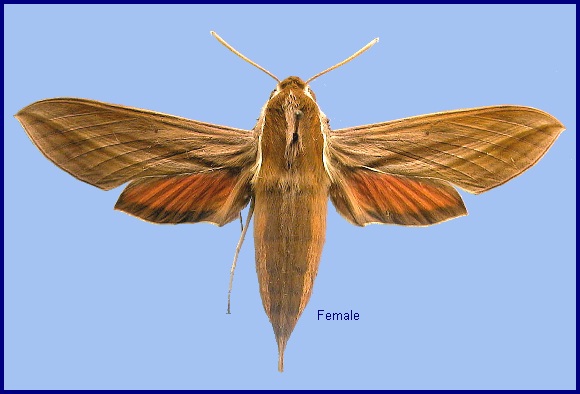
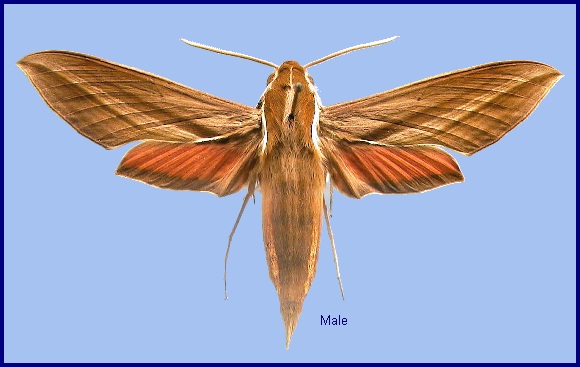
Deilephila rafflesii Moore, [1858], in Horsfield & Moore, Cat. Lepid. Ins. Mus. East India Company 1: 276. Type locality: [Indonesia,] Java [Jawa].
Synonym. Deilephila rafflesii Moore, [1858].
Synonym. Chaerocampa vinacea Hampson, 1893.
Wingspan: 56--70mm. Very similar in colour to Hippotion boerhaviae but upperside of body and forewings deeper brown. Hindwing upperside with an orange-pink (not buff) tornal patch.
In the male genitalia, uncus sharply sinuate as in Hippotion echeclus, with shorter lobes than in Hippotion boerhaviae. Gnathos abruptly narrowed to a sharp hook. Harpe similar to Hippotion echeclus but more rectangular. Juxta short, triangular. Phallus very similar to Hippotion echeclus, 0-3 teeth on the right and a row of teeth on the left. In the female genitalia, ostium bursae wit proximal and lateral edges raised into a somewhat lyre-shaped ridge.
The moths come readily to flowers and are also attracted by light (Bell & Scott, 1937). Attracted to the flowers of Ixora and Lantana camara in Hong Kong.
China: iv-xii (Hong Kong); vii-viii (Guangdong); x (Guangdong).
Kendrick (2002) states that this species is multivoltine in Hong Kong, occurring from late April until late December.
OVUM:
LARVA: Full-fed 70--80mm, width 10mm, horn 9mm. According to Bell & Scott (1937), in the first instar yellow with a straight black horn of medium length. In the second instar, green with small eye-spots on segments 5 and 6. By the third instar, head and segments 2 and 3 green, rest of body green dotted with white. There is an eye-spot on 5, which is yellow edged above and below with black. A slightly smaller eye-spot is present on 6, which is white edged above and below with black. A white dorso-lateral stripe runs from segment 4 to base of horn. The latter is straight, brown with red base. In the fourth instar the head and body is pale green, dotted with white except on head, segment 2 and anal flap. The eye-spot on 5 is longitudinally oval, the pupil yellow edged broadly above with black and below by two black lines. On segment 6 the pupil is pale pink, edged below by a single line. The horn is long, slightly up-curved, tip truncate, black with the tip livid white.
In the final and fifth instar, head round, clypeus equilaterally triangular, basal angles slightly rounded, one-half length of clypeus. Apex of false clypeus widely arched, reaching to two-thirds length of head; labrum one-half as long as clypeus, tapering slightly frontad; ligula as long as labrum and nearly as broad as long, kidney-shaped, with the lobes narrowly rounded; mandible with cutting-edge toothed. Surface of head dull and smooth. Body dull and smooth, with segments 4 and 5 not much swollen. Horn straight, of medium length, thin, tapering evenly to a blunt point; minutely tuberculate (Bell & Scott, 1937).
In the green form, head and body grass-green, with a dorso-lateral line of small ochreous spots on segments 3 and 4, and a large semicircular eye-spot on 5. In the latter the chord dorsad, the pupil black with a white band along the top, edged broadly above, narrowly elsewhere with yellow, the whole enclosed by a black line. There is a smaller, similarly shaped eye-spot on 6, in which the pupil is maroon-red edged with yellow above, the whole enclosed by a black line. There is a dorso-lateral stripe from the hind edge of this eye-spot to base of horn, which is ochreous on the front half of each segment, pale yellowish on the hinder half. Above and below this line, down to the supra-spiracular stripe, there are a number of short, narrow, dark green stripes across each secondary ring. Just above the stripe there are two blue dots near the front margins of 7 to 11, and a narrow white subspiracular stripe with some white dots round the spiracles above it, from 5 to 12. Horn blackish, tip white. Legs deep flesh-colour; venter white with a violet ventral stripe. Spiracles oval, pure white with a narrow black rim. There is also a dark-coloured form of the larva in which the ground-colour is earthen-sepia, the dorso-lateral stripe and the area below it pinkish; the other markings similar to those of the green form but darker.
The description of the larva of this species given in Rothschild & Jordan (1903, p. 756), is undoubtedly that of H. rosetta, as it states that the larva has seven eye-spots. Bell & Scott (1937) bred a large number of larvae of H. rafflesi from different localities, and they were invariably as described above, with two eye-spots.
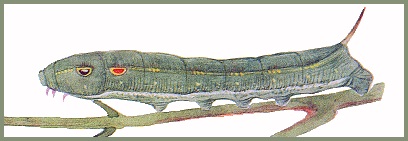
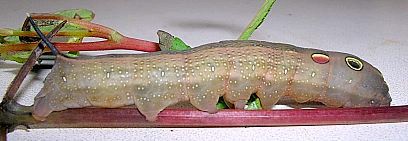
PUPA: 50--60mm., width 10mm. Colour pale yellowish-brown, tongue and inner margin of wing dark brown; sides of tongue-case, and legs, speckled with black; abdomen with a brown ventral stripe, interrupted at segment margin; a blackish dorso-lateral dot on each segment; spiracles brick-coloured; cremaster brown, the shaft black. Rather slender in build; tongue-case, very prominent, projecting a long way in front of the head (6.5mm), the head and projecting sheath together being one-sixth the length of the pupa; tip of tongue spatulate. Antenna equal to fore leg and reaching to one-half length of wing-case; a long, thin coxal piece; apex of wing-case pointed. Surface moderately shiny; head, thorax and wing-case shallowly, transversely corrugate. There is a depression below eye near base of tongue; abdomen shallowly, transversely corrugate, the front bevels and front margins of segments 9 to 14 also pitted. Spiracle of 2 a narrow slit covered by a transverse lobe projecting from the front margin of 3, remaining spiracles elongate-oval, surface rising slightly to the central slit, which has a raised edge. Cremaster triangular, ending in a needle; ventral surface with a deep mesial channel; surface smooth and shiny (Bell & Scott, 1937).

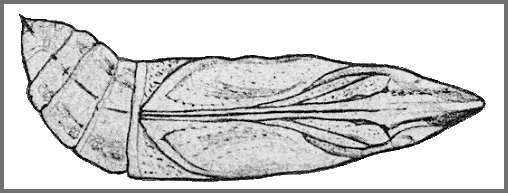
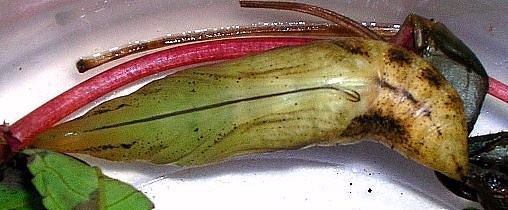
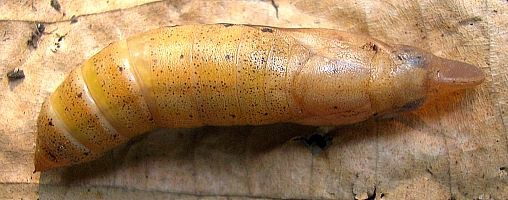
Larval hostplants. Impatiens (Balsaminaceae) (Robinson et al., 2001).
In Laos and Thailand, recorded from Amaranthus (Eitschberger & Ihle, 2008).
China: Yunnan (Pingbian; Gaoligong Shan); south Xizang/Tibet (Zhangmu, 2200m; Yi'ong, 2700-3300m; Yadong, 2900m); Guangdong (Dinghushan; Longtou Shan; Luofu Shan; Wanzishan, Deqing; Shenzhen); Macau; Hong Kong; Hainan (Jianfengling National Forest Park).
Taiwan: Xinshe (Taichung Hsien); Keelung City (Taipei Hsien).
Sri Lanka, southern and eastern India, Nepal, Bhutan (Irungbam & Irungbam, 2019), Burma/Myanmar, Thailand, southern China, Vietnam (Le & Vu, 2024), Malaysia (Peninsular), Indonesia (Sumatra, Java, Sulawesi), the Philippines.
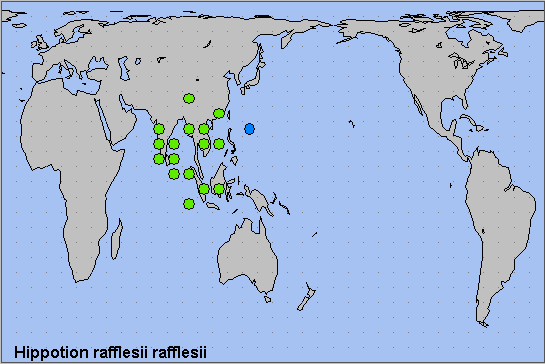
 Return to Sphingidae of the Eastern Palaearctic species list
Return to Sphingidae of the Eastern Palaearctic species list